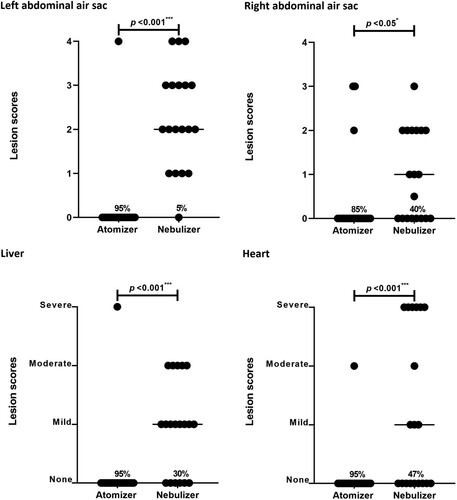Figures & data
Figure 1. Reisolation of colony-forming units from the trachea and air sacs of birds.
Note: The number of colony-forming units (CFUs) reisolated from swabs taken from either the trachea (top panel) or left abdominal air sac (bottom panel) of each bird exposed to aerosols of APEC E956 or sterile media via the atomizer or nebulizer. Each dot represents the number of CFUs isolated from a single bird and the horizontal line represents the medians of the CFUs for each group. The number of birds from which APEC was not reisolated is indicated by the percentages (%) at the base of the graph. P < 0.001*** significant difference in number of CFUs reisolated, n.s. = non-significant; Mann–Whitney test.
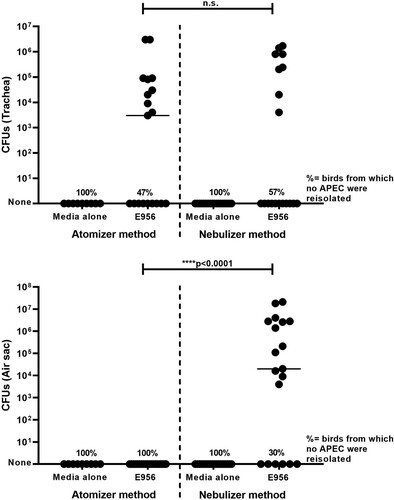
Figure 2. Mean body weight gains of birds.
Note: Body weight gains for birds exposed to aerosols produced by the atomizer (left panel) or the nebulizer (right panel). Each dot represents the weight gain of a single bird from day 1 of the experiment until the time of necropsy, and the horizontal bar represents the mean. P < 0.001*** significant difference in weight gains, n.s. = non–significant; Mann–Whitney test.
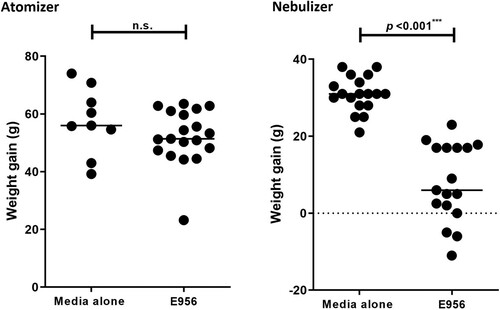
Figure 3. Survival of birds.
Note: Kaplan-Meier analysis was performed such that birds found dead or exhibiting clinical signs and subsequently euthanized were considered mortalities. The “atomizer media” and “nebulizer media” lines represent the per cent survival of birds for the duration of the experiment following exposure to sterile media. The “atomizer E956” and “nebulizer E956” lines represent the per cent survival of birds over the duration of the experiment following exposure to APEC E956.
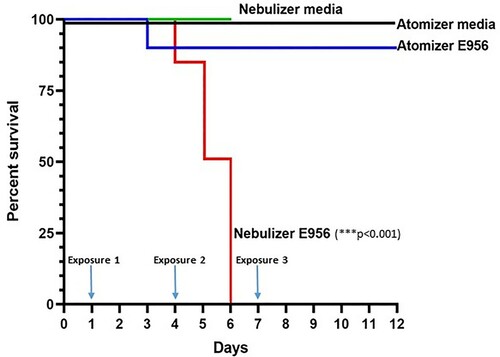
Figure 4. Clinical progression of disease in birds after APEC exposure.
Note: Clinical signs observed in birds throughout the duration of the experiment were defined as mild, moderate or advanced, and were shaded in increasing intensity as illustrated in the key. No detectable clinical signs were observed in birds exposed to APEC E956 via the atomizer, whilst the clinical signs 72 h after exposure to APEC E956 using the nebulizer progressed from mild to advanced.
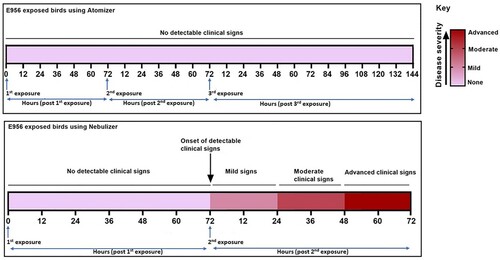
Table 1. Number of birds displaying clinical signs of disease following exposure to APEC E956.
Figure 5. Lesion scores of air sacs, liver and heart following exposure to APEC E956.
Note: At post-mortem examination, lesions typical of airsacculitis, pericarditis and perihepatitis were scored. Each dot represents the score given for the left abdominal air sac, right abdominal air sac, liver and heart for an individual bird and horizontal lines represent the median lesion score. The number of birds without lesions is indicated by the percentage at the base of the graph. P < 0.05*, P < 0.01**, P < 0.001*** significant difference in lesion scores using a Mann–Whitney test.
